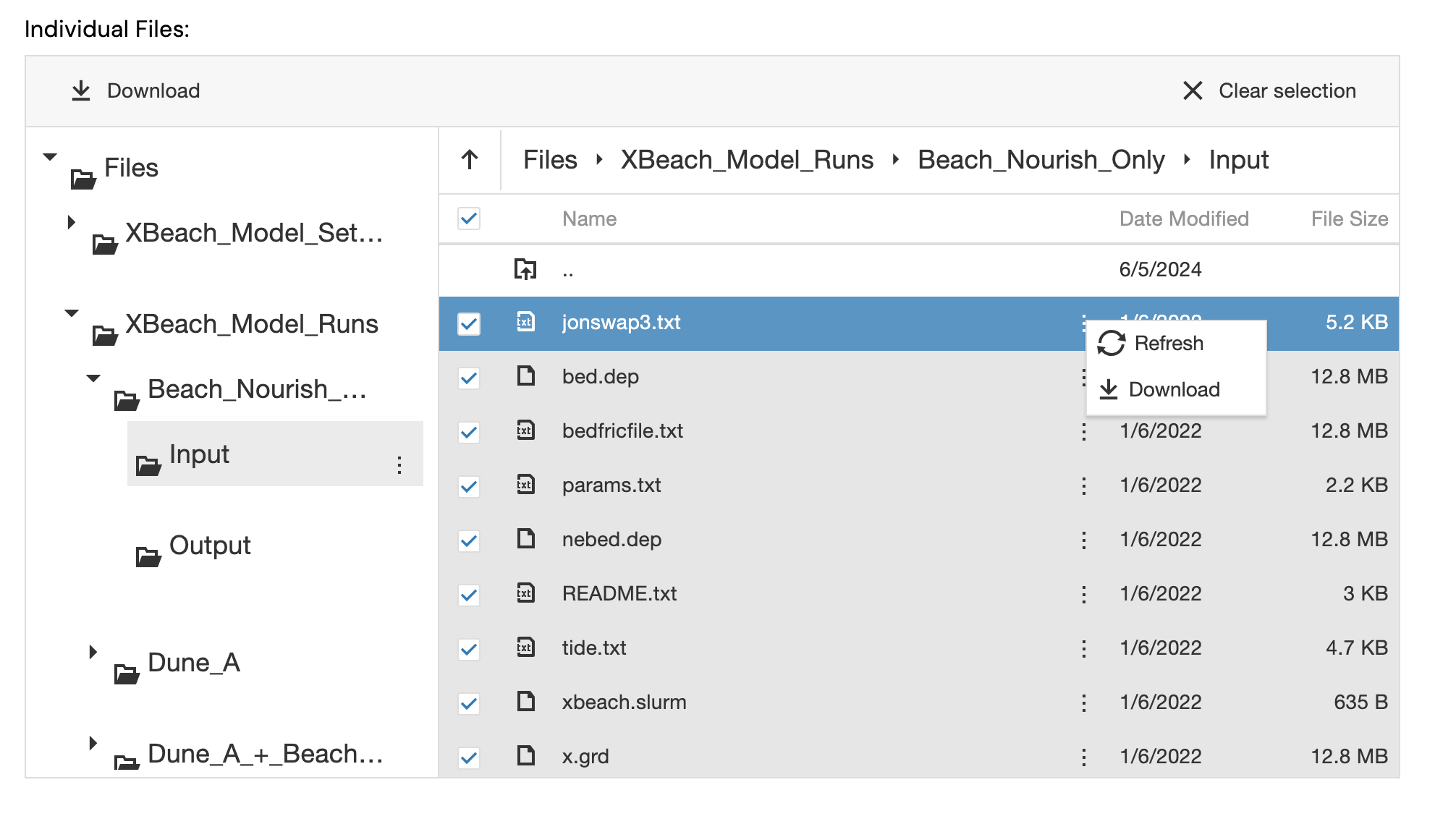In this guide, we will walk you through setting up and running XBeach using the Inductiva API.
We will cover:
Configuring XBeach simulations using the Inductiva API.
Example code to help you get started with simulations.
An advanced example (Galveston Island Beach and Dune Simulation)
Available benchmarks to test XBeach’s capabilities.
XBeach#
XBeach is a two-dimensional simulator used for modeling wave propagation, sediment transport, and morphological changes in the nearshore environment.
XBeach is configured using a params.txt file, which contains crucial details
like the grid, bathymetry, wave input, and flow parameters. The absence
of a params.txt file will prevent the simulator from running, so it is
essential to ensure all necessary files are in place.
The configuration also involves using additional files like bed.dep for
bathymetry and other files to further customize the simulation within
params.txt.
We recommend setting the mpiboundary argument in the params.txt file
to facilitate automatic parallelization based on the number of available
CPU cores.
Example Code#
Below is an example of running a basic XBeach simulation via the Inductiva API:
"""XBeach example."""
import inductiva
# Instantiate machine group
cloud_machine = inductiva.resources.MachineGroup( \
provider="GCP",
machine_type="c2-standard-4")
# Download example configuration files from Inductiva storage
input_dir = inductiva.utils.download_from_url(
"https://storage.googleapis.com/inductiva-api-demo-files/"
"xbeach-input-example.zip",
unzip=True)
# Initialize the Simulator
xbeach = inductiva.simulators.XBeach()
# Run simulation with configuration files in the input directory
task = xbeach.run( \
input_dir=input_dir,
sim_config_filename="params.txt",
on=cloud_machine)
task.wait()
cloud_machine.terminate()
task.download_outputs()
task.print_summary()
Advanced Example: Galveston Island Simulation#
In this example, we’ll run an extensive simulation using configuration scripts and data from GRIIDC, a repository at Texas A&M University-Corpus Christi’s Harte Research Institute for Gulf of Mexico Studies.
Prerequisites#
Download Input Files: We’ll use a dataset from “XBeach model setup and results for beach and dune enhancement scenarios on Galveston Island, Texas,” available here.
Go to the dataset page.
Under Files >> XBeach_Model_Runs >> Beach_Nourish_Only >> Input, download all files in this directory:

Place these files in a
Beach_Nourish_Onlyfolder, resulting in a structure like:
ls -las Beach_Nourish_Only
total 130976
0 drwxr-xr-x 12 paulobarbosa staff 384 Nov 6 10:15 .
0 drwx------@ 124 paulobarbosa staff 3968 Nov 6 10:14 ..
8 -rw-r--r--@ 1 paulobarbosa staff 3069 Nov 6 10:14 README.txt
26184 -rw-r--r--@ 1 paulobarbosa staff 13404906 Nov 6 10:14 bed.dep
26184 -rw-r--r--@ 1 paulobarbosa staff 13404906 Nov 6 10:14 bedfricfile.txt
16 -rw-r--r--@ 1 paulobarbosa staff 5324 Nov 6 10:13 jonswap3.txt
26184 -rw-r--r--@ 1 paulobarbosa staff 13404906 Nov 6 10:14 nebed.dep
8 -rw-r--r--@ 1 paulobarbosa staff 2296 Nov 6 10:15 params.txt
16 -rw-r--r--@ 1 paulobarbosa staff 4850 Nov 6 10:14 tide.txt
26184 -rw-r--r--@ 1 paulobarbosa staff 13404906 Nov 6 10:14 x.grd
8 -rw-r--r--@ 1 paulobarbosa staff 635 Nov 6 10:14 xbeach.slurm
26184 -rw-r--r--@ 1 paulobarbosa staff 13404906 Nov 6 10:14 y.grd
Overview#
Here’s the code you’ll be working on as we progress through the tutorial. Don’t worry if it doesn’t all make sense right now; everything will become clearer in the upcoming steps.
import inductiva
cloud_machine = inductiva.resources.MachineGroup(
provider="GCP",
machine_type="c3d-highcpu-90",
spot=True,
data_disk_gb=20)
cloud_machine.start()
input_dir = "Beach_Nourish_Only"
# Initialize the Simulator
xbeach = inductiva.simulators.XBeach()
# Run simulation with config files in the input directory
task = xbeach.run(
input_dir=input_dir,
sim_config_filename="params.txt",
n_vcpus=90,
on=cloud_machine)
# task.wait() is a blocking call and will only return when the simulation
# ends. However, you can close your terminal without interrupting the
# simulation and use Inductiva CLI (Command Line Interface) tools to
# check the status of the simulation from another terminal.
task.wait()
# Terminate your dedicated MachineGroup at then end of the simulation.
cloud_machine.terminate()
# Let's get a small summary of the run.
task.print_summary()
Step 1: Adjust Simulation Parameters#
For a faster simulation, modify the params.txt file:
Add
single_dir = 0after the header (Needed because we are running XBeach v10+).Change
tstopto34560for a shorter simulation.
Step 2: Running the Simulation#
a. Configure and Start Machine#
Pick your machine:
In this simulation, we’ll use a
c3d-highcpu-90machine with a 20 GB disk.import inductiva cloud_machine = inductiva.resources.MachineGroup( provider="GCP", machine_type="c3d-highcpu-90", spot=True, data_disk_gb=20)
Note:
spotmachines are a lot cheaper but can be terminated by the provider if needed.Start your machine
cloud_machine.start()
b. Define Simulation Inputs#
Specify Simulation Directory: Let’s start by defining a variable that points to the
Beach_Nourish_Onlyfolder where all your simulation files are located.input_dir = "Beach_Nourish_Only"
c. Run Your Simulation#
Run the simulation: We now have everything we need to run our simulation.
# Initialize the Simulator xbeach = inductiva.simulators.XBeach() # Run simulation with config files in the input directory task = xbeach.run( input_dir=input_dir, sim_config_filename="params.txt", n_vcpus=90, on=cloud_machine)
In this snippet, two arguments might need clarification:
n_vcpus: This sets the number of virtual CPUs (vCPUs) for your simulation, essentially determining how many parts your simulation will be split into to run in parallel. Here, we’re dividing the simulation into 56 parts and running each part simultaneously.
Wait for the simulation to finish: That is it. Our simulation is now running on the cloud. We can
waitfor the simulation to finish while we grab a coffee (☕️).task.wait()
Note: run
inductiva logs task_idto check thestdoutof the simulation process in real time.Terminate Machine: Once our simulation completes, we can/should terminate our machine to save on costs. If you forget, don’t worry—we’ve got you covered. By default, the machine will automatically shut down if idle for 30 minutes with no simulation running.
cloud_machine.terminate()
Check your simulation summary: Now that our simulation is complete, we can print a summary with key details, including execution times, generated outputs, and more.
task.print_summary()
Conclusion#
Running the simulation on a high-performance machine it’s simple and easy. And the great benefit is that you can run multiple simulations in parallel, saving you time and money. You can also seamlessly udate the machine you run your simulation. Scaling it up or down as you need.
Download and analyze your results locally once complete.
Happy simulations!
Available Benchmarks for XBeach#
To better understand how you can optimize your XBeach runs, check out our benchmark:
Cova Gala Beach Simulation: This benchmark demonstrates XBeach’s performance across different hardware configurations for simulating coastal erosion at Cova Gala Beach in Portugal, an area known for high erosion rates.